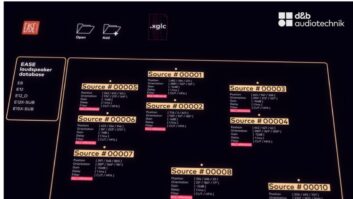The Long-Term Perspective & the Value of Life-Cycle Revenue
Mar 1, 2001 12:00 PM,
Alan Kruglak
IN BUSINESS, HOW YOU LOOK AT something, your perspective onwhether the proverbial glass is half-empty or half-full, can oftenmean the difference between profit and loss, success and failure.That became evident when we hired a consultant to review ourmarketing and sales program in 1991. During his review of our salesorganization, he probed and asked questions about our clients. Heasked how long our clients stayed with us. Why did they remainloyal? What would cause them switch to a competitor? What wouldhappen if we didn’t win a project? Which type of client andproducts generated the greatest profit? And so on. His questionsforced us to re-examine the nature of our relationship withclients.
CHALLENGING THE TRADITIONAL VIEW
Prior to his arrival, we viewed our relationship with clients asa mutually beneficial one the client had needs that we would meet,supported by a high level of service. Regardless of whether thebusiness was from an existing account or a prospect, all orders andprojects had to meet minimum profit levels. Since our salescompensation plan was directly tied to gross margin, the morecompetitive a project was, the lower the commission would be forthe sales rep. If competitive pressure required our prices to dropbelow a certain threshold, no commission would be possible, and wewould walk away from the project. We did that because all potentialprojects were evaluated financially as stand alones single projectswith single payoffs for the immediate bottom line.
Of course, when you walk away from an order, no one in yourorganization is happy. To rationalize our response, we wouldcommiserate, asking each other how our competitor could be sostupid as to contract at such a low price. We would think, Boy, arethey going to get clobbered! What fools! When we went after anyproject, we didn’t consider the potential for additional revenuethat could be generated from projects down the road. Our focus wasalways on how much gross margin the project could generatetoday.
With our consultant’s help, we started to re-examine ourrelationships with most of our clients. Like a whack on the side ofthe head, the findings were eye-opening, permanently changing ourbusiness strategy.
DISCOVERY 1:
LIFE-CYCLE REVENUE
As a systems integrator, we discovered that winning a new clientusually meant the client would be with us for as long as theysurvived as an entity. We defined the length of our relationshipsomewhere between five and 10 years as the client’s life cycle. Andwe defined all the revenue generated from a client over theduration of the business relationship as Life-Cycle Revenue.
Analyzing our relationships with our largest clients, ourrecords showed that over the years a new client would, on average,generate LCR of more than 500% of the initial contract amount!Although we didn’t believe it at first, the numbers provedotherwise. In fact, that 500% was true for our industry as awhole.
The Source of LCR. Our company earned LCR from a number ofsources. The biggest chunk came from additions and re-orders.Another substantial amount of LCR came from recurring revenuesources such as service contracts. Considerable LCR also came fromreferrals. Companies in the same industry watch to see whichproducts and services their competitors use. The thinking is, Ifit’s good enough for our competitors, then it’s good enough for us.This is how we won Sprint as a client: they saw our successful workfor MCI and sought us out.
Lateral employment moves also improve LCR. Say a key contact atan existing client switches companies. The first thing he or shewill do when procuring systems integration products and services iscall a familiar face with a good performance track record that’syou! Cases like this are a major contributing factor to LCR.
DISCOVERY 2:
FAILURE IS NOT AN OPTION
A review of our client relationships also showed that our clientattrition rate was negligible. Obviously, a good part of oursuccess and retention rate was the result of doing what we said wewould do providing the best solutions and supporting them with astrong technical infrastructure.
But it goes beyond that. Reviewing our past wins and losses, ourresearch showed that losing a new project made it nearly impossiblefor us to penetrate that same account over the subsequent fiveyears, even if our competitor provided mediocre service. This meansthat failure to win a new account is clearly not an option.
In the early 1990s, we were competing against seven companiesbidding on a system at a local airport. Throughout the pre-bidprocess, the client would bang his hand on the table, stating in anassured tone, We want quality, and we’ll pay for quality. But welowered our margins anyway to be more aggressive.
After all of the bids were submitted, six of the bids, includingours, were clustered around $1 million. But there was one bid atthe $500,000 mark. Our brains turned sideways. We knew our costswere higher than that. How could anyone bid that low? Besides, theclient wanted quality, right?
The low-bid competitor took exception to almost every conditionin the specification, reducing his costs and, sure enough, he wonthe project. Despite the client’s insistence on quality, pricebecame the overriding factor. My first mistake was believing thatprice wouldn’t be an issue. My second mistake was misjudging mycompetitor. I thought their low price meant they were incompetentand would go paws up. That’s not what happened.
All of the LCR over the next five years from this project,totaling more than $4 million, went directly to our competitor.Although our intelligence indicated that our competitor’s serviceperformance was below average, the client refused to allow us tobid on changes or take over the service work. This continued forfive long years, until a new operations manager came to the airportand decided to replace low-performing service providers.
WHY DOES LIFE-CYCLE REVENUE WORK?
Whether you sell security systems, fire alarms, audio-visual,interconnect or any other type of low-voltage solution, the conceptof LCR is universal and works to increase sales and profits.However, there are some caveats that directly affect the power andfinancial return of LCR. I call this the Commodity VersusProprietary Product Continuum.
On one side of the continuum are commodity products. A commodityis defined as a product or service that is perceived as the exactsame thing no matter where you buy it. The more your product isperceived as a commodity, the more susceptible your company is toprice competition and predation, substantially reducing the powerof LCR. From a client’s perspective, the company providing thecommodity product or service adds little or no value to the finaldelivered product. Examples of commodity items are water, cola andconsumer electronics.
On the other side of the spectrum are proprietary products. Aproprietary product is a product or service that is exclusivelyavailable from a single source. The more your product is perceivedas proprietary, the less susceptible your company is to pricecompetition. This substantially increases the power and effect ofLCR. Products that fit into this category include additions toexisting technical systems and/or products, highly complextechnical products, products only available through your companyand so on. The more unique the product, the greater the proprietarynature and the power of LCR.
Once you understand this continuum, it’s easier to see why it isdifficult for a competitor to penetrate your existing accounts andwhy LCR works.
- The Power of Established Relationships. Once the system orproduct has been purchased and delivered, the client-vendorrelationship is typically well-established. It’s a difficult bondto break, even if your competitor is offering the same product orsolution. Why? Switching to another vendor may jeopardize amanager’s job security. For most corporate managers, job securityis attained by providing products and services that work reliablyand do not disrupt daily business activities. More times than not,this is the reason prospects are reluctant to break a relationshipwith an existing vendor they are afraid of the risk associated withchange.There are, however, three conditions under which clients mightbe willing to seek alternatives to a current vendor. First, theclient perceives the current vendor’s product as a commodity, withthe vendor adding little or no value. Second, the client’s job ison the line as a result of the vendor’s non-performance. Third, theproduct/service delivered does not meet the client’s performanceexpectations. When any of these conditions exists, the client willconsider breaking the client-vendor relationship, interrupting theflow of LCR.
- Technology-Specific Solutions. The more technicallysophisticated your product, the greater the power of LCR. Althoughthe technology may not be under your exclusive purview, mosttechnical products are distributed on a limited basis through aselect network of dealers. Limited distribution blocks most firmsfrom serving your clients’ systems.The same rules apply to security systems, fire alarms,information technology and other electronic systems. Thetechnological barrier to providing quality support is too high,increasing the risk of changing to another supplier.The power of LCR becomes absolute if you are the solemanufacturer and/or provider of a specific technical product.Providing a 100% proprietary product makes you the sole-sourceprovider, locking in any and all future LCR.
- Inertia and the Path of Least Resistance. Customers arereluctant to change companies because they are concerned abouttransition trauma. They generally take the path of least resistanceby maintaining the existing vendor relationship. That means a lostbid results in all of the spoils of victory going to yourcompetitor over the next five years.Of course, the reverse holds true if you win the initial projectyour competitors have to hurdle the same five-year barrier whileyou’re sitting pretty. That’s another reason why failure can’t bean option.
DO ALL PRODUCTS FIT THE LCR MODEL?
Not all products sold to end users have substantial LCR power.As stated earlier, commodity products have low LCR potential andare more subject to price sensitivity and competition. But sellingcommodity products doesn’t necessarily mean you have to sit theretwiddling your thumbs as your competitors eat away at yourbusiness. You can use branding to give any commodity-type product amore proprietary nature.
The concept of branding is straightforward and can apply to allcompanies. The idea is to give a unique name and identity to acommon product or service to enhance its perceived value in themarket place. There are dozens of examples of effective branding.One example of great branding is Godiva chocolate. It comeselegantly wrapped in a gold box. Although my wife insists Godivachocolate is better than Hershey’s, I can’t agree that it’s worth900% more per ounce! The Godiva example illustrates that theappropriate branding of a commodity product enables you not only tosell it easily, but at premium prices.
At my former company, we took a select number oflimited-distribution products, gave them a brand name and printedmarketing literature with the new name and our logo. Even thoughthe same product was being distributed by others in our market, ourclients perceived that it was proprietary to our company. As aresult, all additions and re-orders were placed through ourcompany, adding to the LCR.
Branding can also be applied to services. We used branding todifferentiate our service support program from our competitors. OurFull Service Program included unique features like guaranteedinstant replacement, minimum response times, maximum down-timeproviding significant added value. Branding works because itincreases the real or perceived value of your product. It also canshift your product from the commodity toward the proprietary end ofthe continuum, increasing the power of LCR.
Did we ever misjudge LCR potential? Sure, but more times thannot we were right on target. By officially adopting LCR as part ofour new sales compensation plan, we were able to expand our clientbase, increase our revenue from existing clients and boost profitsall by simply changing our perspective.
This article is an excerpt from Alan Kruglak’s new book, SalesCompensation, The Hunter-Farmer Way, a step-by-step guide tocreating the ultimate compensation program to drive the salesprocess. Universal to almost any business in the systemsintegration industry, this book provides new strategies forcompensation, productivity, territories, incentives, pricing andmore. For more information, please call ARK Solutions at301/365-7522 or visit the Web site at www.arksolutions.net.
What We Learned and What We Did
AFTER REVIEWING OUR CLIENT BASE with our consultant, wediscovered the following:
- LCR Exists. Although not an official part of our salesstrategy, LCR exists throughout our customer base.
- Failure is Not an Option. The key to generating life-cyclerevenue is being there first. If you fail to do that, you’ll have adifficult time breaking the client-vendor relationships of yourcompetitors.
- Deliver Quality Products and Services. Selling to a new clientis only part of the battle the client must perceive that youdeliver good service and/or products. I say perceive because theclient’s perception is what determines repeat business. Sometimesinertia takes over even when you’ve done a less-than-superior job,but if you provide good service and deliver a good product, it’ssafe to assume that the majority of your clients will not only dothe easy thing, they’ll also do the right thing they’ll stick withyou.
- Branding Increases the Proprietary Nature of Products. Byrenaming our products and services, we secured more revenue fromexisting clients and eliminated predation by competitors.
- Power of LCR. LCR was one of the key reasons for our high grossmargins and revenue growth.
Recognizing the results, we changed our perspective. Weredirected our sales strategy to take a more aggressive posturetoward new clients. Instead of looking at the financial merits of aspecific order at one point in time, we looked at the entirepotential revenue stream that could be generated from a client overtime. If a client had significant LCR potential, we would reduceour pricing to whatever level necessary to win the order.










